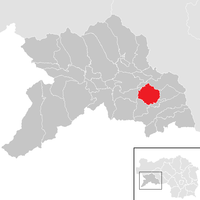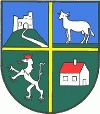Mariahof
| Mariahof (former municipality) | ||
|---|---|---|
|
|
||
| Basic data | ||
| Pole. District , state | Murau (MU), Styria | |
| Judicial district | Murau | |
| Coordinates | 47 ° 5 '57 " N , 14 ° 23' 57" E | |
| height | 963 m above sea level A. | |
| Residents of the stat. An H. | 1225 (January 1, 2016) | |
| Building status | 430 (2001 ) | |
| surface | 31.13 km² | |
| Postcodes | 8812, 8820 | |
| prefix | + 43/3584 (Neumarkt in Styria) | |
| Statistical identification | ||
| Community code | 61439 | |
| Counting district / district | Mariahof (61439 003) | |
 Location of the former municipality in the Murau district |
||
| Independent municipality until the end of 2014; KG: 65301 Adendorf, 65302 Baierdorf; OS: 15996 Baierdorf, 15997 Mariahof Source: STAT : Directory of places ; BEV : GEONAM ; GIS-Stmk |
||
Mariahof was a municipality with 1225 inhabitants until the end of 2014 (as of January 1, 2016) in the judicial district or district of Murau in Styria . As part of the municipal structural reform in Styria , it has been merged with the municipalities of Dürnstein in Styria , Kulm am Zirbitz , Neumarkt in Styria , Perchau am Sattel , Sankt Marein bei Neumarkt and Zeutschach since 2015 ; the new municipality is called Marktgemeinde Neumarkt in Styria further. The basis for this is the Styrian Municipal Structural Reform Act (StGsrG).
geography
Mariahof is located in the Murtal on the Neumarkter Sattel , a pass road that connects the Murtal with the Metnitztal .
structure
The former community consisted of 17 districts until 2015 (without individual farms , scattered houses , Rotten , ruins and inns): Forst, Baierdorf, Schachen, Rußdorf, Bahnhof, Adendorf, Vockenberg, Neudorf, Steinberg, Hoferdorf, Oberdorf, Diemersdorf, Ob der Kirche , Berg, Stadlob, Klachel and Lambach. In 1948 the following districts of Mariahof existed: Ob der Kirche, Egg, Steinberg, Adendorf, Adelsberg, Lambach, Schauerfeld, Rutztorf, Forst, Oberdorf, Vockenberg, Stadlob, Diemersdorf, Klachl, Berg, Hoferdorf, Baierdorf, Neumarkt.
history
The parish church was first mentioned in a document in 1066 as “ecclesia Grazluppa”. In 1103 it was added to the St. Lambrecht Benedictine Abbey . The church, which was rebuilt in the 14th century, was renovated between 1482 and 1511 in the late Gothic style after its destruction by the Hungarians and converted into a fortification.
local community
The local community, founded in 1849/50, consisted of the cadastral communities of Adendorf and Baierdorf, was originally called Adendorf and was renamed Mariahof in 1881.
population
According to the 2001 census, the municipality had 1,327 inhabitants, 99.1% of the population had Austrian citizenship. 94.4% of the population committed to the Roman Catholic Church, 3.7% were without religious belief.
The population has remained almost unchanged since 1951 (1,391).
Culture and sights
- Steinschloss ruin : The former fortress was built around 1131 and is 1180 m above sea level, making it the highest castle in Styria.
- Mariahof Parish Church of the Assumption
- Zirbitzkogel-Grebenzen Nature Park
- Furtner pond : The pond that was created during the Ice Age is now embedded in a 13 hectare nature reserve. He became known through Blasius Hanf , a father of the Benedictine monastery of St. Lambrecht , who was one of the most important ornithologists in Austria in the 19th century.
- Vivarium: The Vivarium is Mariahof's nature park information center. In addition to the native flora and fauna, flora and fauna of the Amazon region are also presented. The vivarium has been closed since October 3rd, 2011 after financial and capacity problems. The newly founded Natechnikum opened in the building on July 17, 2015 .
- Dürnberger Moor: The Dürnberger Moor is a mountain pine upland moor that is around 12,000 years old. It is around 16 hectares in size and overgrown with peat moss of the species Magellan's peat moss ( Sphagnum magellanicum ) and reddish peat moss ( Sphagnum rubellum ). The plants found here include the Scheidige cotton grass , the rosemary heather , the cranberry , the bog bilberry and the common heather . The black grouse is one of the animal species found here .
Economy and Infrastructure
Mariahof is a summer tourist destination with around 30,000 to 35,000 overnight stays. In the manufacturing industry, wood processing plays the largest role, and there is also a gravel works.
The area has a station at the Rudolfsbahn at the Mariahof- Sankt Lambrecht stop (formerly the train station ) . From 1945 to 1951, the Sankt Lambrecht trolleybus also ran from there to the dynamite plant of the Dynamit Nobel company .
politics
The municipal council consisted of 15 members until the end of 2014 and has been composed of mandates from the following parties since the municipal council election in 2010:
The ÖVP provided the last mayor in Florian Plank and the last deputy mayor in Josef Maier.
coat of arms
The municipal coat of arms was awarded on September 10, 1930. Due to the amalgamation of the municipalities, it lost its official validity on January 1, 2015.
Blazon (coat of arms description):
- “A shield divided into four by a gold crosshair. In the upper right blue field a castle ruin made of white masonry rises on a green hill. A steeply rising path leads to the ruins from the left Untereck. In the upper left field, which is also blue, stands a yellow-brown colored cow on a green lawn. In the lower right green field a red-crowned and armed silver panther appears, poking flames from its throat. In the lower left, likewise green field, a building made of white masonry and roofed in red rises on a light green ground. The shield is surrounded by an ornamented bronze-colored border. "
Personalities
Honorary citizen
- 1975 Friedrich Niederl (1920–2012), governor
Sons and daughters of Mariahof
- Heinz Gach (* 1947), ÖVP politician , state hunter master
- Robert Gratzer (1948–2004), journalist, writer
- Franz Benedikt Hermann (1755–1815), geologist and mining specialist
- Benedikt Plank (* 1949), Benedictine and Abbot of St. Lambrecht
- Ernst Schindlbacher (* 1938), politician of the ÖVP
- Gottfried Schröckenfuchs (* 1947), officer
literature
- Walter Brunner : Mariahof. History of the life and suffering of the people of a small region from the beginning to the present . Self-published by the local community Mariahof, Mariahof 2004
- Walter Sepp: 900 years of Mariahof parish . Judenburg 1966
Web links
Individual evidence
- ↑ residents by locality (Excel file, 835 kB); accessed on August 29, 2016
- ^ Municipal structural reform - the further timetable | Mariahofer information. Retrieved on February 4, 2020 (German).
- ^ Styrian municipal structural reform .
- ↑ Section 3, Paragraph 7, Item 2 of the Act of December 17, 2013 on the reorganization of the municipalities of the State of Styria ( Styrian Municipal Reform Act - StGsrG). Provincial Law Gazette for Styria of April 2, 2014. No. 31, year 2014. ZDB -ID 705127-x . P. 3.
- ↑ Mariahof | new market town Neumarkt | Styria | Austria. Retrieved February 4, 2020 .
- ↑ Mariahof | Graz-Seckau, rk. Diocese (Styria) | Austria | Matricula Online. Retrieved February 4, 2020 .
- ^ Announcement of the kk governor in Styria on October 21, 1881 regarding the change of the name of the municipality of Adendorf to that of Mariahof.
- ↑ Info. Retrieved June 19, 2019 .
- ↑ Communications from the Styrian State Archives 13, 1963, p. 77





